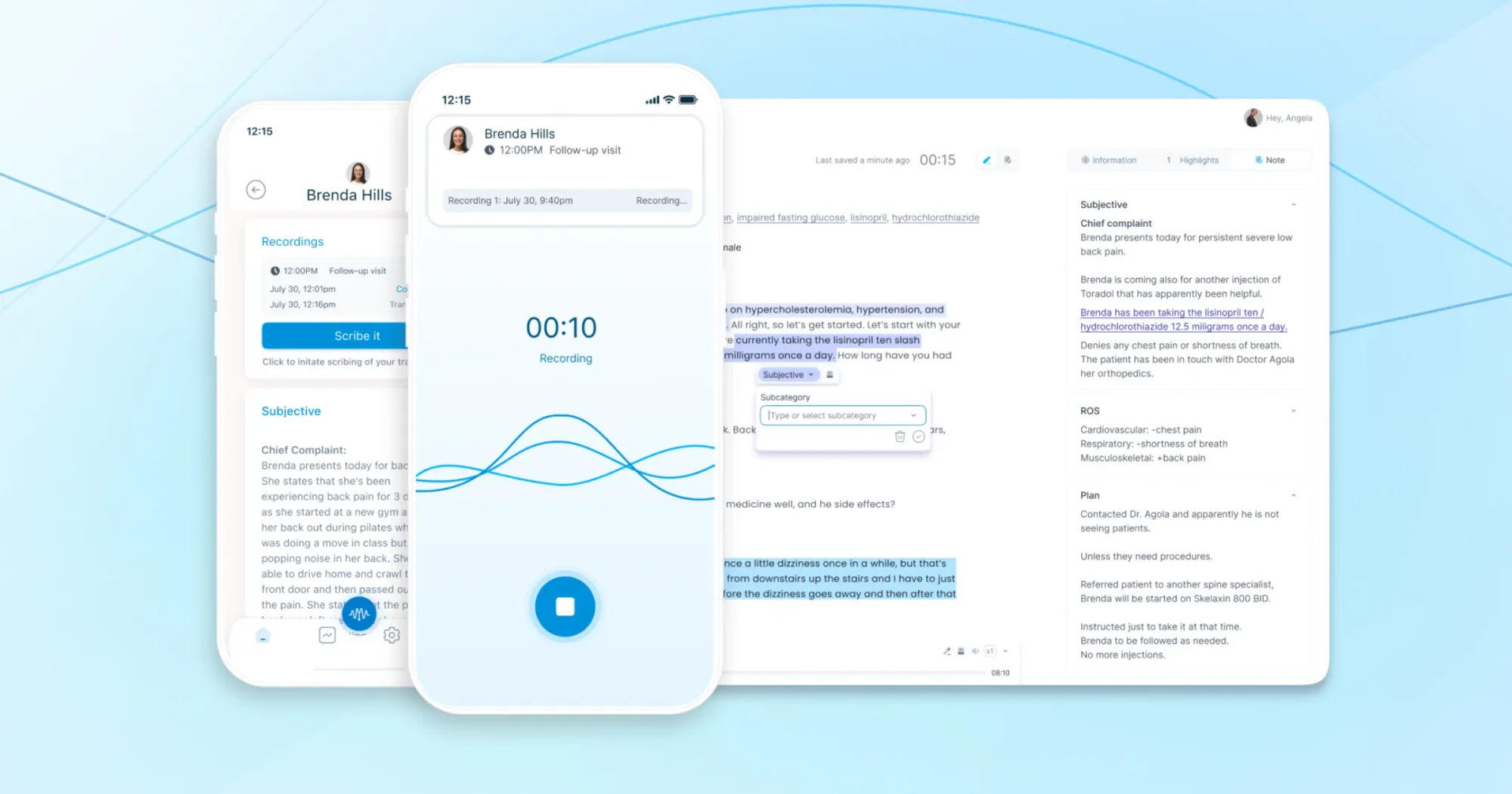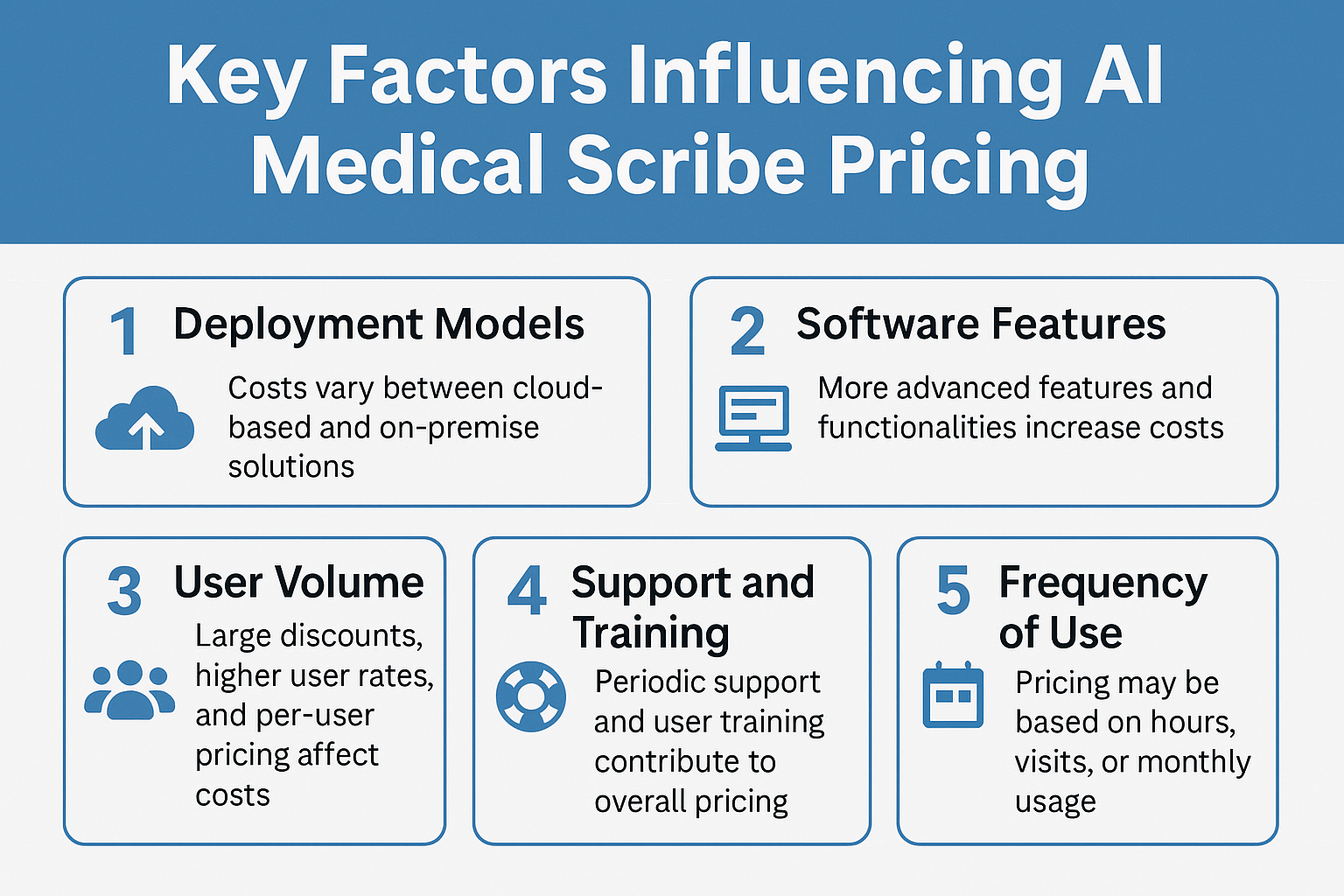Different Pricing Models for AI Scribes

The advent of a major technological revolution has been transforming a wide range of industries across the globe. Artificial intelligence (AI) is creating buzz worldwide and revolutionizing the entire process of how organizations function. It has transformed several clinical procedures by leaving significant impressions on the healthcare system. AI scribes are one such aspect that has been a game-changer for clinical documentation in this rapidly evolving healthcare sector. With these AI-enabled digital tools, doctors are able to focus on the patients more than on administrative activities and tasks.
According to a journal at the National Library of Medicine, The Permanente Medical Group (TPMG) opted for AI scribe technology, and based on its report, almost 3,442 TPMG medical professionals used the tool for 303,266 patients. As healthcare professionals and facilities proactively embrace this technological marvel, the main question remains about AI medical scribe pricing.
Being aware of the cost of the medical scribe is essential for organizations with limited budgets and resources, as well as for individual medics intending to achieve maximum value at a budget-friendly price. Assessing the cost of a medical scribe powered by AI is highly essential owing to multiple factors, including the increasing operational costs, reduced reimbursements, and the need for efficient workflows. The market has a wide range of solutions with a broader range of prices which differs based on features of the solution, vendors, and service opportunities.
This article explores the emergence of AI medical scribes, the factors driving the cost, and the price models.
AI Medical Scribes: A Brief Overview

AI medical scribes are software solutions that leverage NLP or natural language processing and ML or machine learning, enabling documentation of the interaction between a patient and a medical professional. Although the concept of scribes is not new and can be traced back several centuries, and they were primarily humans, the newer concept uses technology to automate the process. It is integrated with the electronic health records (EHRs), which streamlines the data entry efficiently.
Adopting AI medical scribe software helps doctors focus on providing medical care, minimize burnout, improve accuracy, and increase patient satisfaction. Other significant benefits include improved clinical workflow, operation, and patient care. Based on Healthcare professionals, AI Medical Scribe can save time on documentation while focusing on the patients and spending more time on their work. According to Medicity News, an article published in the Journal of the American Medical Informatics Association, where the study was conducted at Stanford, stated that an AI scribe decreases the time of documentation. This enhances the patients' satisfaction rate and offers accurate medical documentation.
Additionally, organizations seem to benefit financially with higher productivity, accurate coding, and the potential for increased revenue with more patients. Although the cost of medical scribe software might be on the higher end, investing in the AI-powered scribe is worth the value it offers.
What are the Key Factors Influencing AI Medical Scribe Pricing?
The price range of the medical scribe driven by artificial intelligence can differ from one model to another and depends on multiple factors. No two scribe software can offer the same value. When checking out the costs for these powerful tools, healthcare companies should make sure to consider more than the base price. The essential factors comprise the deployment strategies and the functional features of the software, the number of users, required support, and the pattern of use. All these jointly combine to play a pivotal role in determining the AI Medical Scribe Pricing.
Deployment Models
The cost for an AI medical scribe tends to differ based on whether it is deployed in the cloud, making it a cloud-based software solution, or it is on-premise. Cloud-based solutions tend to have specific subscription models and offer scalability, automatic upgrades, and decreased infrastructure requirements. On the contrary, the installations that take place on-premise requires more investment in hardware, installation services, and IT maintenance and support. In addition, the organizations opting for the scribes should also consider the frequent security updates and maintenance. The AI scribes based on clouds are comparatively more flexible, while the on-premise option can be availed by companies looking for special compliance and control.
Software Features
The features of the software play a crucial role in determining the overall cost of the medical scribe driven by AI. As the number of features of the software increases so is the cost of the AI scribe. Several medical scribe software come with advanced features and functionalities such as real-time voice recognition, extensive EHR integration, customized documentation templates, and multilingual assistance. These types of scribes tend to cost more than those with limited features. Additionally, the systems that adopt cutting-edge ML models for comprehension of the context alongside clinical logic offer an improved accuracy rate of the documentation, thereby contributing to the higher cost price. Organizations can evaluate the features, choose the ones that would be required and beneficial for them, and save on the cost.
User Volume
Another essential factor that directly impacts the cost of medical scribe software is the number of users using the system. There are vendors that can offer major discounts for a large group of users, thereby making it cost-effective for the numerous provider practices as well as hospital networks. However, fewer users with smaller practices might have to pay more as the per-user rate will increase in such a scenario. Gaining insights and comprehending the volume of users impacting the AI medical scribe cost facilitates improved forecasting and vendor comparison, particularly for businesses that are contemplating growth.
Support and Training
Periodic support and maintenance is essential to ensure optimal performance of the scribe software. However, this tend to increase the expenses and might exceed the budget limit. While some vendors already include onboarding, user training, and technical support services within their package, other vendors charge extra for those. Receiving high-standard support and guidance regarding the technical issues will ensure that the problems are resolved fast and improve system performance, further instilling user confidence. When assessing the entire cost of AI medical scribe software, it is crucial to consider these factors, especially for teams that are not familiar with AI-powered solutions.
Frequency of Use
There are several brands that create pricing ranges based on the frequency of software use. It is determined based on hours, patient visits, or monthly usage. Medical organizations with a higher number of patients can benefit by adopting the plans offering a flat price or unlimited usage. On the other hand, the ones that experience the low volume of patients tend to benefit from the per-visit pricing plan. It is crucial to consider selecting a pricing strategy for AI scribe that matches the actual usage patterns, thereby preventing any kind of underutilization or over usage and spending an extra price. Opting for accurate usage is essential for calculating the budget and the return on investment.

Based on the factors mentioned above, healthcare organizations can choose the AI medical scribe that suits their requirements and also matches their overall budget. Physicians such as Dr Bhattacharya, a family doctor at Women’s College Hospital in Ontario, said that the tool costs for the doctors working in that community range from $100 to $400 monthly, and the prices can be reduced with bulk purchases.
Understanding the Pricing Models for AI Medical Scribe
The cost of medical scribe software depends on multiple factors, which have already been discussed above. However, most vendors offer certain basic pricing models for medical scribes powered by AI. Each model caters to unique organizational requirements and patterns of use. Comprehending the pricing models is essential in choosing a cost-effective and value-driven solution that will help in growth and development. Multiple vendors across the market offer competitive prices. As per Dr. Spencer Dorn, Vice Chair of Medicine and Professor at UNC Chapel Hill, the AI medical Scribes have been commoditized with several vendors in the market.
Here are the basic pricing models for AI medical scribes:
Subscription-based Model
One of the most common and widely used pricing models available in the market for medical scribes driven by AI is the subscription-based model. In such a type of model, the provider pays a fixed price monthly or annually per user. In return, they get the accessibility to the main software, regular updates, required basic support, and integrations. Depending upon the various features and services included within the plan, the price range tends to vary. This type of structure is suitable for organizations with a familiar number of users and workloads. Certain vendors also offer different pricing within the software subscription model that enables the clients to choose from the various feature sets categorized as basic and advanced.
Pay-per-use Model
This is another popular pricing model for the AI scribe, where the clients have to pay for each clinical engagement, documentation appointment, or transcription. This type of pricing structure is best for the clinics and practitioners that deal with unpredictable patient volume. The pay-per-use model ensures financial flexibility and safeguards from the underutilization of the scribe services. This is because, in this model, the client tends to pay whatever they use, thereby limiting the budget and promoting cost-effectiveness. On the contrary, with a higher volume of patients, this type of model can turn out to be expensive compared to the subscription-based models. Hence, healthcare organizations and clinics with a large number of patient workload should refrain from this model.
Custom Enterprise Solution
The custom enterprise solution pricing model of AI Scribe is mainly designed for large healthcare organizations and hospitals that experience various documentation workflows. Here, the system is tailored as per the specific needs of the concerned organization, and the pricing is structured based on the volume of users, necessary integrations, execution scope, and advanced features of the software. The cost tends to be charged annually or negotiated based on the contract. In this type of pricing structure, the clients can expect to receive regular and optimal support for technical issues, distinctive customization, on-site training, and service-level agreements. The overall cost for such AI-powered scribes is on the higher end, which is justified by the smooth operational efficiency.
The AI Medical Scribe Pricing tends to differ based on the structured pricing model, thereby representing the various requirements of the clients. It is essential to choose the model based on the designated budget and the long-term organizational goals.
Budgeting Tips: Choosing the Right AI Scribe
Several clinics and healthcare organizations adopting AI medical scribes for the first time struggle to choose the right solution based on their budgets and requirements. Here are some tips to help them manage pricing efficiently.
Initiate with a pilot program
Start by testing the software with a handful of people, which will help in evaluating the software performance. This will enable the stakeholders to comprehend the value of the AI scribe before investing in it completely.
Use free versions at first
Clinics and doctors should use the free version or explore the trial periods to explore the software features and functionalities. This helps them understand if the software solution matches the organizational requirements.
Negotiate contracts
Vendors tend to offer major discounts for longer periods of commitment or larger groups. It is better to discuss the price early before the procurement process starts, thereby enabling better savings.
Calculate and compare the total expense
Organizations planning to invest in AI scribes must look beyond the monthly cost and include other essential expenses in the calculation. Other costs include implementation, training, support, and the integration process, which represents the overall cost scenario.
Evaluate software scalability
Software scalability is highly crucial and should be considered for organizational growth and development. Selecting a flexible and scalable software solution for AI scribes can prevent additional future charges.
Key Takeaway
The AI medical scribe pricing differs across the market from one vendor to another. This is mainly owing to the features, the size of the providers, usage volume, and the pricing model an organization selects. For the clinics with limited budgets, the chief agenda is to get hands-on a solution that can offer optimal performance and is within their budget preference. Striking the right balance between these 2 factors is tricky. Hence, assessing the overall costs is the next step in gaining insights on the cost of the AI medical scribe.
DocAssistant is an AI Scribe with multiple pricing plans that are affordable and within budget limitations for most Emergency Departments and Urgent Cares. By using DocAssistant, users can leverage the power of AI to save time and effort while focusing more on patients. They can experience evidence-based clinical recommendations, peer review, and patient notes.
About the Author
Nathan Murray, M.D. Emergency Medicine - Founder of DocAssistant
Dr. Nathan Murray is an Emergency Medicine trained physician and the founder of DocAssistant. With years of frontline clinical experience, Dr. Murray is passionate about using AI to streamline medical documentation and improve care delivery.



